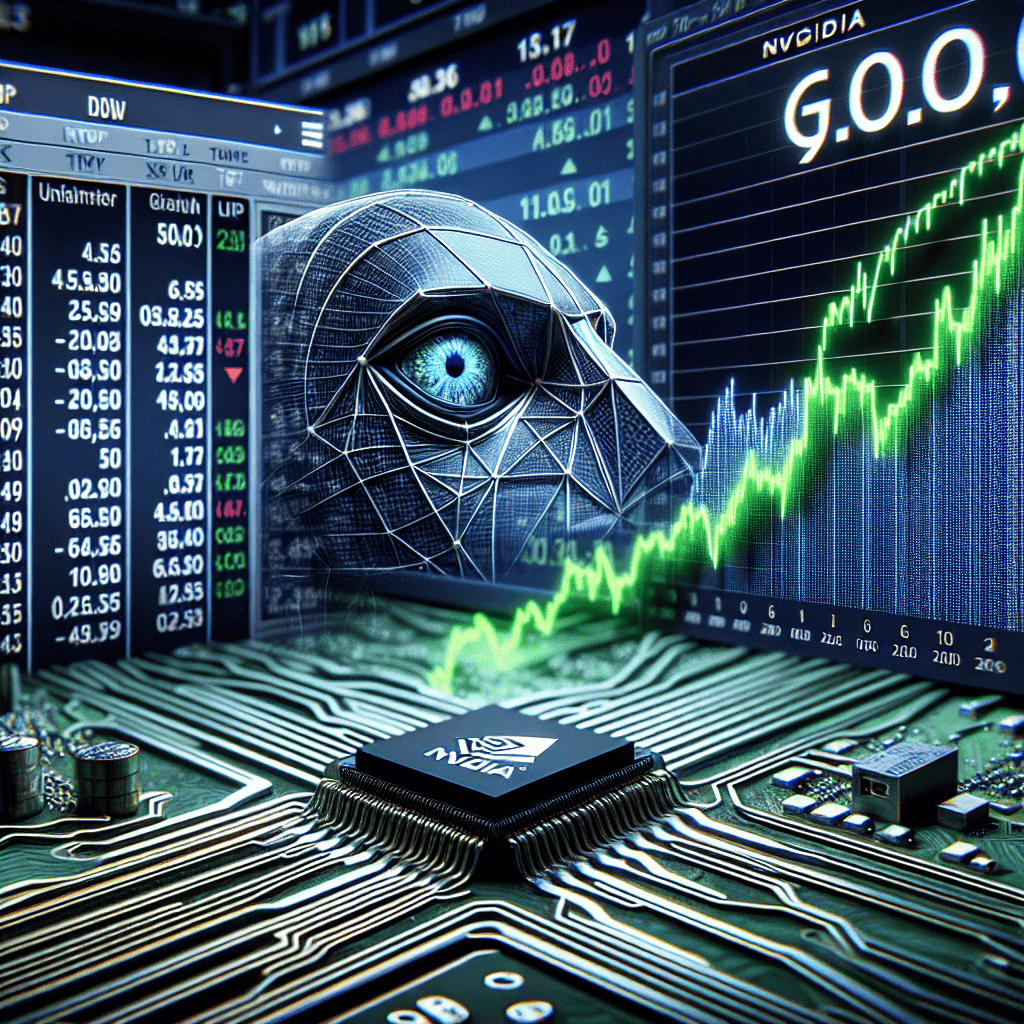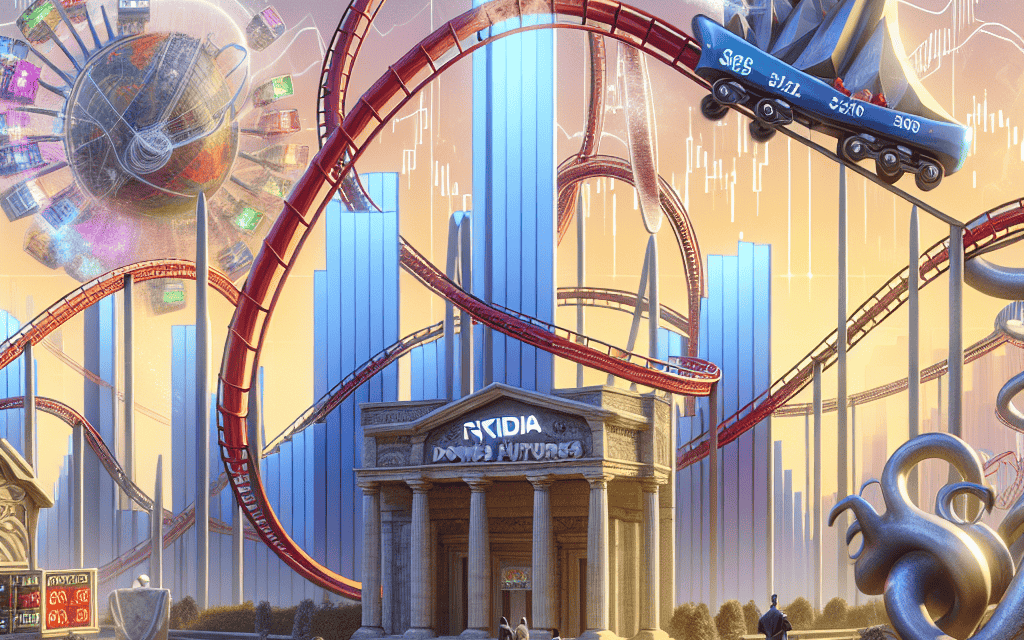“Election Shifts Propel Dow Jones Futures; S&P 500 Soars as Nvidia Joins the Dow”
Introduction
Dow Jones Futures are closely monitored as significant election changes loom, potentially impacting market dynamics. Investors are anticipating major gains in the S&P 500, driven by evolving political landscapes and economic policies. Additionally, Nvidia, a leading technology company, is poised to join the Dow Jones Industrial Average, marking a significant shift in the index’s composition. This inclusion reflects Nvidia’s growing influence in the tech sector and its potential to drive market performance. As these developments unfold, market participants are keenly observing the implications for future trading sessions and investment strategies.
Impact Of Election Changes On Dow Jones Futures
As the political landscape undergoes significant shifts, investors are keenly observing the potential impact on Dow Jones futures. The anticipation surrounding election changes is palpable, with market participants closely monitoring how these developments might influence economic policies and, consequently, the stock market. Historically, elections have been pivotal in shaping market trends, as they often herald changes in fiscal and regulatory policies that can either bolster or hinder economic growth. In this context, the current election cycle is no exception, with analysts predicting substantial movements in the Dow Jones Industrial Average and the broader S&P 500 index.
The prospect of major gains in the S&P 500 is particularly noteworthy. Analysts suggest that the market is poised for a rally, driven by expectations of favorable policy shifts that could stimulate economic activity. Such optimism is often reflected in futures trading, where investors place bets on the direction of market indices. The anticipation of policy changes that could lower corporate taxes, increase infrastructure spending, or deregulate certain industries tends to buoy investor sentiment, leading to an uptick in futures prices. Consequently, the Dow Jones futures are likely to experience heightened volatility as election results unfold and policy directions become clearer.
In addition to the broader market implications, specific stocks are also under the spotlight. Notably, Nvidia, a leading player in the semiconductor industry, is set to enter the Dow Jones Industrial Average. This inclusion is significant, as it reflects the growing importance of technology companies in the modern economy. Nvidia’s entry into the Dow is expected to bring a fresh dynamic to the index, given the company’s strong performance and its pivotal role in sectors such as artificial intelligence, gaming, and data centers. The addition of Nvidia is likely to attract increased attention from investors, potentially driving further gains in the index.
Moreover, the inclusion of Nvidia underscores a broader trend within the stock market: the increasing dominance of technology firms. As these companies continue to innovate and expand their influence across various industries, their impact on market indices becomes more pronounced. This shift is indicative of a changing economic landscape, where traditional industries are gradually being overshadowed by tech-driven growth. Consequently, investors are recalibrating their portfolios to capitalize on this trend, further fueling the momentum in technology stocks.
As the election changes unfold, it is crucial for investors to remain vigilant and adaptable. The interplay between political developments and market dynamics can be complex, with numerous factors influencing outcomes. While the potential for major gains in the S&P 500 is enticing, it is essential to consider the broader economic context and the specific policies that may emerge from the election. By staying informed and responsive to these changes, investors can better navigate the uncertainties and opportunities that lie ahead.
In conclusion, the impact of election changes on Dow Jones futures is a topic of considerable interest and importance. As market participants assess the potential implications of new policies, the anticipation of significant gains in the S&P 500 and the inclusion of Nvidia in the Dow are key focal points. These developments highlight the evolving nature of the stock market and underscore the need for investors to remain attuned to both political and economic shifts. As the situation continues to evolve, the ability to adapt and respond to these changes will be crucial in achieving investment success.
Major S&P 500 Gains: What Investors Should Expect
As investors keenly observe the financial markets, the anticipation surrounding the Dow Jones futures is palpable, especially in light of the upcoming election changes. The potential shifts in political leadership and policy can significantly impact market dynamics, and investors are preparing for the possible outcomes. In this context, the S&P 500, a key benchmark for the U.S. stock market, is expected to experience major gains. This optimism is fueled by a combination of factors, including economic indicators, corporate earnings, and strategic shifts within major companies.
One of the primary drivers of the anticipated gains in the S&P 500 is the robust performance of several key sectors. Technology, healthcare, and consumer discretionary stocks have shown resilience and growth potential, even amid economic uncertainties. The technology sector, in particular, continues to be a powerhouse, with companies like Apple, Microsoft, and Amazon leading the charge. These firms have not only demonstrated strong earnings but have also shown adaptability in navigating supply chain challenges and evolving consumer demands.
Moreover, the healthcare sector remains a focal point for investors, especially as advancements in biotechnology and pharmaceuticals promise new opportunities for growth. The ongoing development of innovative treatments and vaccines continues to attract significant investment, further bolstering the sector’s performance. Meanwhile, consumer discretionary stocks are benefiting from a resurgence in consumer spending, driven by pent-up demand and increased savings accumulated during the pandemic.
In addition to sector-specific dynamics, broader economic indicators are also contributing to the positive outlook for the S&P 500. The labor market has shown signs of recovery, with unemployment rates gradually declining and job creation on the rise. This improvement in employment figures is a crucial factor, as it directly influences consumer confidence and spending, which are vital components of economic growth. Furthermore, inflationary pressures, while present, are being closely monitored by the Federal Reserve, which has signaled its commitment to maintaining a balanced approach to monetary policy.
Amid these developments, a significant change is on the horizon for the Dow Jones Industrial Average, with Nvidia set to enter the index. Nvidia, a leader in graphics processing technology and artificial intelligence, has seen remarkable growth in recent years. Its inclusion in the Dow is a testament to the evolving landscape of the stock market, where technology companies are increasingly taking center stage. This move is expected to bring fresh momentum to the index, attracting new investors and potentially driving further gains.
As investors navigate these changes, it is essential to remain vigilant and informed. The interplay between political developments, economic indicators, and corporate performance will continue to shape market trends. While the outlook for the S&P 500 appears promising, it is crucial to consider potential risks and uncertainties that may arise. Geopolitical tensions, regulatory changes, and unexpected economic shifts could all impact market dynamics.
In conclusion, the anticipation surrounding the Dow Jones futures and the expected gains in the S&P 500 reflects a complex interplay of factors. As Nvidia prepares to join the Dow, investors are poised to capitalize on emerging opportunities while remaining mindful of potential challenges. By staying informed and adaptable, investors can navigate the evolving landscape and make strategic decisions that align with their financial goals.
Nvidia’s Entry Into The Dow: Implications For The Market
The financial landscape is poised for significant shifts as Nvidia, a leading player in the technology sector, prepares to enter the Dow Jones Industrial Average. This move is not only a testament to Nvidia’s growing influence but also a reflection of the broader changes occurring within the market. As investors keep a close eye on Dow Jones futures, the anticipation surrounding Nvidia’s inclusion is palpable, with many expecting major gains for the S&P 500. This development comes at a time when the market is already navigating the complexities of election changes, adding another layer of intrigue to the financial narrative.
Nvidia’s entry into the Dow is a strategic decision that underscores the increasing importance of technology companies in the modern economy. Traditionally, the Dow has been dominated by industrial and financial firms, but the inclusion of a tech giant like Nvidia signals a shift towards a more tech-centric market. This transition is not only indicative of the changing economic landscape but also highlights the growing reliance on technology in various sectors. As Nvidia joins the ranks of other tech behemoths in the Dow, it is expected to bring a fresh wave of innovation and growth potential to the index.
Moreover, Nvidia’s inclusion is likely to have a ripple effect on the S&P 500, with analysts predicting substantial gains. The company’s robust performance and strong market position make it a valuable addition to the index, potentially driving up overall market performance. Investors are optimistic that Nvidia’s presence will bolster the S&P 500, providing a much-needed boost amid the uncertainties of election changes. This optimism is further fueled by Nvidia’s impressive track record of innovation and its ability to adapt to evolving market demands.
In addition to its impact on the indices, Nvidia’s entry into the Dow is expected to influence investor sentiment. The company’s reputation for cutting-edge technology and strategic growth initiatives makes it an attractive option for investors seeking stability and long-term growth. As a result, Nvidia’s inclusion is likely to attract a new wave of investors, eager to capitalize on the opportunities presented by this market shift. This influx of investment could further drive up stock prices, contributing to the anticipated gains for the S&P 500.
Furthermore, Nvidia’s entry into the Dow comes at a critical juncture, as the market grapples with the implications of election changes. The political landscape can have a profound impact on market dynamics, and investors are keenly aware of the potential risks and opportunities that may arise. In this context, Nvidia’s inclusion offers a sense of stability and confidence, providing a counterbalance to the uncertainties associated with political transitions. As investors navigate this complex environment, Nvidia’s presence in the Dow serves as a reassuring indicator of the market’s resilience and adaptability.
In conclusion, Nvidia’s entry into the Dow Jones Industrial Average marks a significant milestone in the evolution of the financial market. Its inclusion not only reflects the growing prominence of technology companies but also signals a shift towards a more diversified and resilient market. As investors watch Dow Jones futures and anticipate major gains for the S&P 500, Nvidia’s presence offers a beacon of stability and growth potential. Amid the uncertainties of election changes, Nvidia’s entry into the Dow is a testament to the enduring strength and adaptability of the market, promising exciting opportunities for investors and stakeholders alike.
Analyzing The Relationship Between Dow Jones Futures And Election Outcomes

The relationship between Dow Jones futures and election outcomes has long been a subject of interest for investors and analysts alike. As the political landscape shifts, so too do the expectations and strategies of market participants. This dynamic interplay is particularly evident during election cycles, where the anticipation of policy changes and economic reforms can lead to significant fluctuations in market indices. The Dow Jones Industrial Average, a key barometer of U.S. economic health, often reflects these anticipatory movements, with futures contracts providing a glimpse into investor sentiment and market direction.
Historically, election outcomes have had a profound impact on market behavior. Investors tend to react to the perceived economic policies of the candidates, with different sectors responding variably depending on the anticipated regulatory and fiscal environment. For instance, a candidate favoring deregulation and tax cuts might boost investor confidence in industrial and financial sectors, leading to a rise in Dow futures. Conversely, a candidate advocating for increased regulation and higher taxes might cause apprehension, resulting in a more cautious market approach.
As the election season progresses, the focus often shifts to the potential for major gains in the S&P 500, another critical index that represents a broader spectrum of the market. The S&P 500’s performance is closely watched as it encompasses a wider array of industries, providing a more comprehensive view of the market’s reaction to political developments. Analysts frequently predict significant movements in this index based on election outcomes, as changes in government policy can have far-reaching implications for corporate earnings and economic growth.
In the current climate, attention is also drawn to the potential inclusion of Nvidia in the Dow Jones Industrial Average. Nvidia, a leading player in the technology sector, has seen substantial growth and innovation, making it a strong candidate for inclusion in this prestigious index. The addition of Nvidia would not only reflect the evolving landscape of the U.S. economy, which is increasingly driven by technology and digital transformation, but also signal a shift in the composition of the Dow to better represent modern economic drivers.
The anticipation of Nvidia’s entry into the Dow is indicative of broader trends within the market, where technology companies continue to play a pivotal role in shaping economic narratives. This potential inclusion underscores the importance of adapting traditional indices to reflect contemporary economic realities, ensuring that they remain relevant and representative of the current market environment.
In conclusion, the interplay between Dow Jones futures and election outcomes is a complex and multifaceted relationship that requires careful analysis and understanding. As investors navigate the uncertainties of political change, they must consider the potential impacts on market indices such as the Dow and the S&P 500. The possible inclusion of Nvidia in the Dow further highlights the need for indices to evolve alongside the economy, capturing the essence of modern market dynamics. As election cycles continue to influence market behavior, investors and analysts must remain vigilant, adapting their strategies to align with the ever-changing political and economic landscape.
S&P 500 Performance: Key Factors Driving Major Gains
The S&P 500, a key benchmark for the U.S. stock market, has been experiencing significant gains recently, driven by a confluence of factors that are shaping investor sentiment and market dynamics. As market participants closely monitor Dow Jones futures in anticipation of potential changes stemming from upcoming elections, the broader economic landscape is also playing a crucial role in influencing the performance of the S&P 500. One of the primary drivers of the recent upward trajectory in the S&P 500 is the robust performance of the technology sector, with companies like Nvidia poised to make a significant impact. Nvidia’s anticipated entry into the Dow Jones Industrial Average is a testament to the growing influence of technology firms in the broader market. This move is expected to further bolster investor confidence, as Nvidia’s innovative advancements in artificial intelligence and graphics processing continue to capture the attention of both consumers and businesses alike.
In addition to the technological advancements propelling the market, macroeconomic factors are also contributing to the S&P 500’s gains. The Federal Reserve’s monetary policy, characterized by low interest rates and quantitative easing measures, has provided a favorable environment for equities. This accommodative stance has encouraged borrowing and investment, thereby fueling economic growth and supporting higher stock valuations. Furthermore, the gradual recovery from the global pandemic has led to increased consumer spending and business investments, which are vital components of economic expansion. As vaccination rates rise and restrictions ease, sectors that were previously under pressure, such as travel and hospitality, are witnessing a resurgence in demand, further contributing to the positive momentum in the stock market.
Moreover, corporate earnings have been a significant factor in driving the S&P 500’s performance. Many companies have reported better-than-expected earnings, reflecting their ability to adapt to changing market conditions and capitalize on emerging opportunities. This trend has instilled confidence among investors, who are increasingly optimistic about the future growth prospects of these firms. The strong earnings reports have also led to upward revisions in analysts’ forecasts, providing additional support for the market’s upward trajectory.
Geopolitical developments, including trade negotiations and international relations, are also influencing market sentiment. Investors are closely watching the outcomes of these discussions, as they have the potential to impact global supply chains and economic stability. Positive developments in trade agreements and diplomatic relations can lead to increased market optimism, while uncertainties or tensions may result in heightened volatility.
As the market navigates these various factors, the upcoming elections are another critical element that investors are keeping a close eye on. The potential for policy changes and shifts in regulatory frameworks can have far-reaching implications for different sectors of the economy. Market participants are particularly interested in how these changes might affect fiscal policies, taxation, and government spending, all of which can influence corporate profitability and, consequently, stock prices.
In conclusion, the S&P 500’s recent gains are the result of a complex interplay of technological advancements, macroeconomic conditions, corporate earnings, geopolitical developments, and political considerations. As investors continue to monitor these factors, the market’s trajectory will likely be shaped by how these elements evolve in the coming months. With Nvidia’s expected entry into the Dow and the potential for election-induced changes, the landscape remains dynamic, offering both opportunities and challenges for market participants.
Nvidia’s Influence On Dow Jones: A New Era For Tech Stocks
As the financial world keeps a close eye on the Dow Jones futures, the anticipation surrounding potential election changes is palpable. Investors are particularly interested in how these changes might influence market dynamics, especially with the major gains expected for the S&P 500. Amidst this backdrop, Nvidia’s impending entry into the Dow Jones Industrial Average marks a significant shift, heralding a new era for tech stocks within this prestigious index.
Nvidia, a leader in the semiconductor industry, has consistently demonstrated robust growth and innovation, making it a formidable player in the tech sector. Its inclusion in the Dow Jones is not merely a reflection of its market capitalization or financial performance but also an acknowledgment of the increasing importance of technology companies in the broader economic landscape. This move is expected to bring a fresh wave of interest and investment into tech stocks, potentially reshaping the composition and performance of the Dow Jones.
The decision to include Nvidia in the Dow Jones comes at a time when the tech sector is experiencing unprecedented growth. With advancements in artificial intelligence, machine learning, and data processing, companies like Nvidia are at the forefront of technological innovation. Their products and services are becoming integral to various industries, from automotive to healthcare, underscoring the pervasive influence of technology in modern society. As such, Nvidia’s entry into the Dow Jones is likely to enhance the index’s representation of the tech sector, aligning it more closely with current economic trends.
Moreover, Nvidia’s inclusion is expected to have a ripple effect on investor sentiment. Historically, the Dow Jones has been viewed as a barometer of the U.S. economy, and changes to its composition can significantly impact market perceptions. By incorporating a tech giant like Nvidia, the index not only gains a company with strong growth prospects but also signals a broader acceptance of the tech sector’s role in driving economic progress. This could lead to increased investor confidence and a subsequent rise in tech stock valuations, benefiting the sector as a whole.
In addition to influencing investor sentiment, Nvidia’s entry into the Dow Jones may also prompt other tech companies to strive for inclusion in the index. This could lead to increased competition and innovation within the sector, as companies seek to enhance their market positions and demonstrate their value to investors. As a result, the tech industry could witness accelerated growth and development, further solidifying its status as a key driver of economic expansion.
While Nvidia’s inclusion in the Dow Jones is undoubtedly a significant milestone, it is essential to consider the broader implications for the index and the market as a whole. As the Dow Jones becomes more tech-centric, it may experience increased volatility, given the fast-paced nature of the technology sector. However, this shift also presents opportunities for diversification and growth, as the index becomes more reflective of the modern economy.
In conclusion, Nvidia’s entry into the Dow Jones marks a pivotal moment for tech stocks, signaling a new era of recognition and influence within the index. As investors watch closely for election changes and their potential impact on the market, Nvidia’s inclusion serves as a reminder of the tech sector’s growing prominence and its critical role in shaping the future of the global economy.
Election Changes And Their Potential Effects On Market Volatility
As the financial world keeps a close eye on the Dow Jones futures, the anticipation surrounding upcoming election changes is palpable. Investors are keenly aware that political shifts can significantly impact market volatility, and the current climate is no exception. With major gains expected in the S&P 500, the potential entry of Nvidia into the Dow Jones Industrial Average adds another layer of complexity to the market dynamics. Understanding how these elements interplay is crucial for investors aiming to navigate the uncertain waters of the stock market.
Elections have historically been a catalyst for market fluctuations, as they often bring about changes in fiscal policies, regulatory environments, and economic priorities. The anticipation of such changes can lead to increased volatility, as investors attempt to predict and react to the potential outcomes. In the current scenario, the market is particularly sensitive to shifts in policy that could affect key sectors such as technology, healthcare, and energy. As these sectors form a substantial part of the S&P 500, any significant policy changes could lead to notable gains or losses within the index.
Moreover, the potential inclusion of Nvidia in the Dow Jones Industrial Average is a development that investors are watching closely. Nvidia, a leader in the semiconductor industry, has seen substantial growth due to its pivotal role in powering advancements in artificial intelligence, gaming, and data centers. Its entry into the Dow would not only reflect its growing influence but also signal a shift in the composition of the index towards more technology-oriented companies. This shift could attract a new wave of investors, further influencing market trends and potentially leading to increased volatility as the market adjusts to this change.
In addition to these factors, the broader economic environment plays a crucial role in shaping market expectations. With inflationary pressures and interest rate adjustments being key concerns, investors are closely monitoring how these elements will interact with the political landscape. The Federal Reserve’s monetary policy decisions, in particular, are likely to be influenced by the election outcomes, as new leadership may bring different perspectives on managing economic growth and stability. This interplay between fiscal and monetary policy is a critical factor that could either amplify or mitigate market volatility in the coming months.
Furthermore, global economic conditions cannot be overlooked. As the world becomes increasingly interconnected, international developments, such as trade agreements and geopolitical tensions, can have a profound impact on domestic markets. Investors must consider how these external factors might influence the U.S. economy and, by extension, the stock market. The potential for increased volatility is heightened by the fact that global markets often react swiftly to changes in the U.S. political landscape, given its significant influence on the world stage.
In conclusion, as the Dow Jones futures watch election changes, investors are preparing for a period of potential market volatility. The expected gains in the S&P 500, coupled with Nvidia’s anticipated entry into the Dow, underscore the dynamic nature of the current market environment. By staying informed and considering the myriad factors at play, investors can better position themselves to navigate the challenges and opportunities that lie ahead. As always, a careful analysis of both domestic and international developments will be essential in making informed investment decisions during this pivotal time.
Q&A
1. **What is the Dow Jones Futures Watch?**
– The Dow Jones Futures Watch is a financial tool that tracks the futures contracts of the Dow Jones Industrial Average, providing insights into market expectations and potential movements before the stock market opens.
2. **How do election changes impact Dow Jones Futures?**
– Election changes can create uncertainty or optimism in the market, influencing investor sentiment and causing fluctuations in Dow Jones Futures as traders anticipate potential policy shifts and economic impacts.
3. **What are the major S&P 500 gains expected?**
– Major S&P 500 gains are expected due to positive market sentiment, strong corporate earnings, or favorable economic indicators that drive investor confidence and increase stock prices within the index.
4. **Why is Nvidia set to enter the Dow?**
– Nvidia is set to enter the Dow due to its significant market capitalization, strong financial performance, and influence in the technology sector, making it a suitable candidate for inclusion in the Dow Jones Industrial Average.
5. **What impact does Nvidia’s inclusion have on the Dow?**
– Nvidia’s inclusion in the Dow can increase the index’s exposure to the technology sector, potentially boosting its performance if Nvidia continues to perform well, and reflecting the evolving landscape of the U.S. economy.
6. **How do futures contracts work in the context of the Dow Jones?**
– Futures contracts in the context of the Dow Jones allow investors to speculate on the future value of the index, providing a mechanism for hedging risk or leveraging potential gains based on anticipated market movements.
7. **What factors contribute to the expected gains in the S&P 500?**
– Factors contributing to expected gains in the S&P 500 include strong corporate earnings reports, positive economic data, investor optimism, and favorable monetary or fiscal policies that support economic growth.
Conclusion
The Dow Jones futures are closely monitoring potential changes related to the upcoming election, which could significantly impact market dynamics. Analysts anticipate substantial gains for the S&P 500, driven by investor optimism and potential policy shifts that may favor economic growth. Additionally, Nvidia’s expected inclusion in the Dow Jones Industrial Average is noteworthy, as it reflects the increasing importance of technology companies in the broader market index. This move could further bolster investor confidence and contribute to the anticipated gains in the S&P 500. Overall, the combination of election-related developments and strategic index adjustments positions the market for notable advancements.





